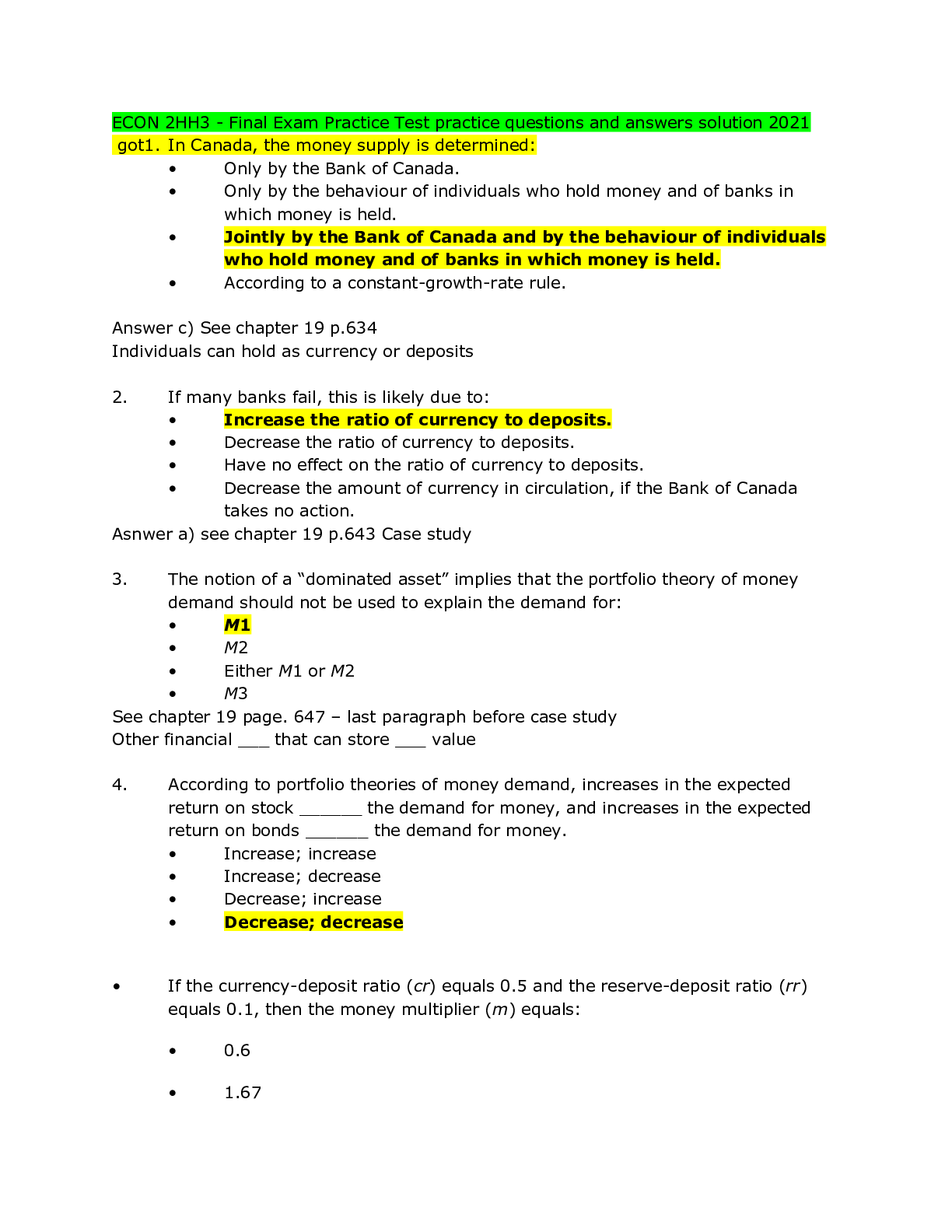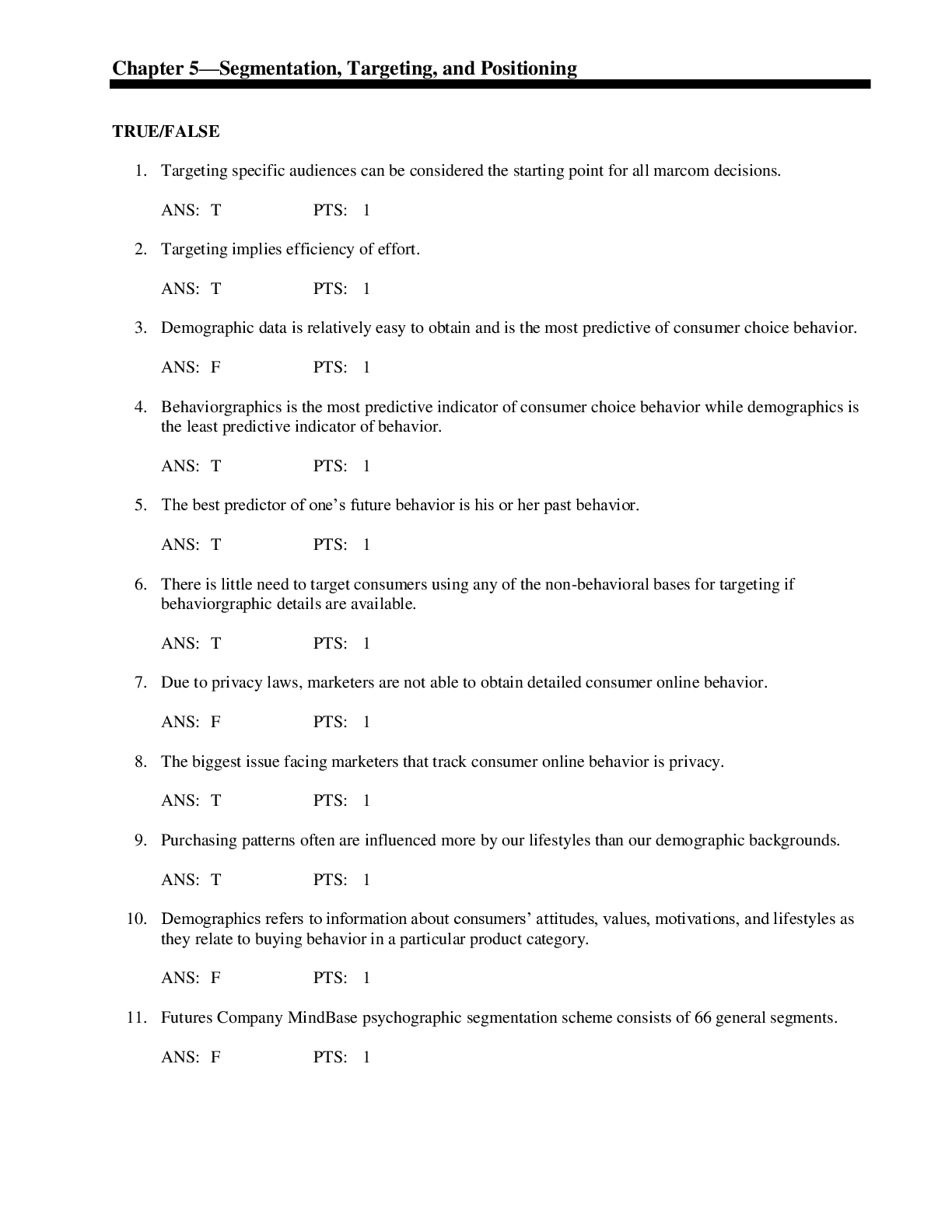Economics > QUESTIONS & ANSWERS > ECON 2HH3 - Final Exam Practice Test practice questions and answers solution 2021 (All)
ECON 2HH3 - Final Exam Practice Test practice questions and answers solution 2021
Document Content and Description Below
ECON 2HH3 - Final Exam Practice Test practice questions and answers solution 2021 got1. In Canada, the money supply is determined: ⦁ Only by the Bank of Canada. ⦁ Only by the behaviour of ind... ividuals who hold money and of banks in which money is held. ⦁ Jointly by the Bank of Canada and by the behaviour of individuals who hold money and of banks in which money is held. ⦁ According to a constant-growth-rate rule. Answer c) See chapter 19 p.634 Individuals can hold as currency or deposits 2. If many banks fail, this is likely due to: ⦁ Increase the ratio of currency to deposits. ⦁ Decrease the ratio of currency to deposits. ⦁ Have no effect on the ratio of currency to deposits. ⦁ Decrease the amount of currency in circulation, if the Bank of Canada takes no action. Asnwer a) see chapter 19 p.643 Case study 3. The notion of a “dominated asset” implies that the portfolio theory of money demand should not be used to explain the demand for: ⦁ M1 ⦁ M2 ⦁ Either M1 or M2 ⦁ M3 See chapter 19 page. 647 – last paragraph before case study Other financial ___ that can store ___ value 4. According to portfolio theories of money demand, increases in the expected return on stock ______ the demand for money, and increases in the expected return on bonds ______ the demand for money. ⦁ Increase; increase ⦁ Increase; decrease ⦁ Decrease; increase ⦁ Decrease; decrease ⦁ If the currency-deposit ratio (cr) equals 0.5 and the reserve-deposit ratio (rr) equals 0.1, then the money multiplier (m) equals: ⦁ 0.6 ⦁ 1.67 ⦁ 2.0 ⦁ 2.5 6. John Maynard Keynes believed that the average propensity to consume: ⦁ Was constant ⦁ Increased as income increased ⦁ Decreased as income increased ⦁ Was less than the marginal propensity to consume See chapter 17 p.575: Keynes felt saving was something for the wealthy felt mpc declined cause there would be higher savings for those with higher income levels 7. Empirical evidence finds that the average propensity to consume is constant (as income changes) for: ⦁ Only the short-run consumption function. ⦁ Only the long-run consumption function. ⦁ Both the short-run and the long-run consumption functions. ⦁ Neither the short-run nor the long-run consumption functions. Simon k responsible for determing that the apc was constant during the LR. Keynes correct for sr and simon for lr. 8. Every indifference curve shows combinations of first-period and second-period consumption that: ⦁ Are tangent to the intertemporal budget constraint. ⦁ Have equal income and substitution effects. ⦁ Are available to the consumer. ⦁ Make the consumer equally happy. Consumer preference; chapter 17 pg 580. 9. According to Modigliani's life-cycle hypothesis, if a consumer wants equal consumption in every year, and the interest rate is zero, there are 40 years until retirement, and 60 years of life remaining, then the marginal propensity to consume out of income equals: ⦁ 0.016 ⦁ 0.40 ⦁ 0.60 ⦁ 0.67 See chapter 17 p.588-589 10. The amount by which government spending exceeds government revenues is called the ______, and the accumulation of past government borrowing is called the ______. ⦁ Deficit; debt ⦁ Debt; deficit ⦁ Devaluation; deflation ⦁ Deflation; devaluation See chapter 17- page 535 Use the following graph to answer Question 11: 11. Based on the graph, if Y1 and Y2 represent income in period one and period two, respectively, r is the interest rate, and the consumer chooses to consume combination A on the budget constraint, what will be the level of consumption in period two, C2? ⦁ Y1(1+ r) + Y2 ⦁ Y1 + Y2/(1 + r) ⦁ Y1/(1 + r) + Y2 ⦁ Y1 + Y2(1 + r) Chapt 17 p580-583 12. Cyclically adjusted budgets are useful because they: a) Systematically account for changes in government assets and liabilities b) Reflect policy changes, but not current economic conditions c) Account for tax burdens on different generations of tax payers d) Correctly account for the impact of inflation on government indebtedness ch.16 p550 13. Compare the traditional view with the view of Ricardian equivalence of the effects of a debt-financed tax cut on: a) National saving: national saving decreases, Ricardian view: national saving is unchanged b) Current consumption: current consumption increases; Ricardian view: current consumption is unchanged 14. Economists who view the economy as naturally stable often argue that: ⦁ Monetary and fiscal policies should not be used to “fine tune” the economy. ⦁ The economy should be stimulated when it is depressed and slowed when it is overheated. ⦁ The economy should be slowed when it is depressed and stimulated when it is overheated. ⦁ Economists should act to stimulate or slow the economy on the basis of forecasts in order to assure that the policy actions are timely. See Chapter 15 p511 3rd paragraph 15. The time between when a recession begins and when the central bank lowers interest rates to stimulate aggregate demand is an example of a(n): a) Inside lag of monetary policy b) Outside lag of monetary policy c) Inside lag of fiscal policy d) Outside lag of fiscal policy inside lag associated with economic disturbance prevailing and the time involved in taking policy action/recognizing it 16. Keeping the money supply constant over the business cycle is an example of: a) Active monetary policy b) Active fiscal policy c) Passive monetary policy d) Passive fiscal policy ch15 p512 17. Along any aggregate supply curve, there is only one: a) Unemployment level b) Expected price level c) Inflation level d) Output level ch.13 pg.432 18. The assumption of rational expectations for inflation means that people will form their expectations of inflation by: a) Optimally using all available information, including information about current policies, to forecast the future b) Asking the opinions of the best experts c) Subscribing to the forecasting service that uses the best econometric model d) Basing their opinions on recently observed inflation ch.13 p444 19. Under a floating system, the exchange rate: a) Fluctuates in response to changing economic conditions b) Is maintained at a predetermined level by the central bank c) Is changed at regular intervals by the central bank d) Fluctuates in response to changes in the price of gold ch.12 pg.385 20. In a small open economy with a floating exchange rate, a rise in government spending in the new short-run equilibrium: a) Chokes off investment, but not by as much as the new government spending. b) Chokes off an amount of investment just equal to the new government spending. c) Attracts foreign capital, thus raising the exchange rate and reducing net exports, but not by as much as the new government spending. d) Attracts foreign capital, thus raising the exchange rate and reducing net exports by an amount just equal to the new government spending. Mundell flemming model q.(look at shocks) see ch.12 p.386 21. In the IS-LM model under the usual conditions in a closed economy, an increase in government spending increases the interest rate and crowds out: a) Prices b) Investment c) The money supply d) Taxes see ch.11 p345-347 22. Possible explanations put forth for the Great Depression do not include: ⦁ A shift in the IS curve ⦁ A shift in the LM curve ⦁ The debt-deflation theory ⦁ The Pigou effect See ch.11 Page 361 23. In the Keynesian-cross model, actual expenditures differ from planned expenditures by the amount of: ⦁ Liquidity preference ⦁ The government-purchases multiplier ⦁ Unplanned inventory investment ⦁ Real money balances See ch.10 Pg.317 24. According to the theory of liquidity preference, if the supply of real money balances exceeds the demand for real money balances, individuals will: ⦁ Purchase interest-earning assets in order to obtain non-interest-bearing money ⦁ Purchase interest-earning assets in order to reduce holdings of non-interest-bearing money ⦁ Purchase more goods and services ⦁ Be content with their portfolios See ch.10 p.333 top 25. In the Keynesian-cross analysis, if the consumption function is given by C = 100 + 0.6(Y – T), and planned investment is 100, G is 100, and T is 100, then equilibrium Y is: ⦁ 350 ⦁ 400 ⦁ 600 ⦁ 750 26. In a steady state: ⦁ No hiring or firings are occurring ⦁ The number of people finding jobs equals the number of people losing jobs ⦁ The number of people finding jobs exceeds the number of people losing jobs ⦁ The number of people losing jobs exceeds the number of people finding jobs 27. All of the following are reasons for frictional unemployment except: ⦁ Workers have different preferences and abilities ⦁ Unemployed workers accept the first job offer that they receive ⦁ The flow of information is imperfect ⦁ Geographic mobility takes time [Show More]
Last updated: 2 years ago
Preview 1 out of 7 pages

Buy this document to get the full access instantly
Instant Download Access after purchase
Buy NowInstant download
We Accept:

Reviews( 0 )
$10.00
Can't find what you want? Try our AI powered Search
Document information
Connected school, study & course
About the document
Uploaded On
Feb 02, 2021
Number of pages
7
Written in
Additional information
This document has been written for:
Uploaded
Feb 02, 2021
Downloads
0
Views
150

 answers.png)
























